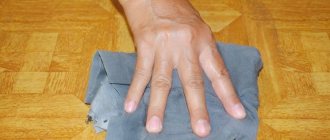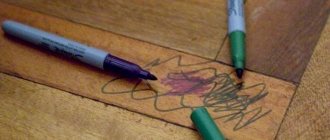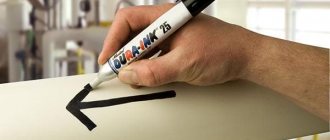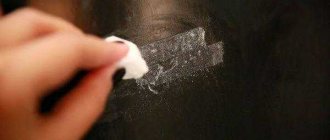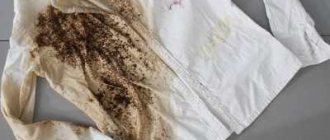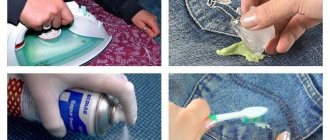Getting rid of unnecessary hair on the legs, intimate area and face using heated wax is an effective method. Only sometimes Wax remains on the skin after the procedure, which cannot be washed off with plain water.
Nobody likes the sticky feeling, and besides, wax residue does not allow the skin to breathe and can cause serious irritation. Let's figure out how you can remove wax from the skin after depilation at home.
Getting rid of greasy stains after wax and paraffin on clothes
It's easy to remove wax or paraffin deposits, but there may be greasy oil stains that also need to be dealt with.
After removing wax residue from the fabric, stains will most likely remain.
Using an iron
If hot processing is applied to the fabric of the contaminated item, use the following method:
- Take a paper napkin or sheet of paper folded several times and place it under the stain.
- Place a napkin on top as well.
- Heat the iron slightly and iron the stain. The fat will melt and be absorbed into the paper. When the napkin gets dirty, you need to change it.
Residues of wax or paraffin will stick to the paper, and it will also absorb grease.
Folk and cleaning products
If the wax is without tinting elements, the easiest way to remove it from delicate fabrics is ammonia, gasoline and special solvents such as White Spirit. You need to moisten a cotton pad or napkin with the chosen product and apply it to the stain for 15–20 minutes, and then wash it.
The easiest way to remove wax is without touch-up elements.
There is gasoline that has an unpleasant odor; after using it, it is better to wash the entire product using conditioner so that the item acquires a pleasant aroma.
You can get rid of greasy stains by preparing a special solution: 50 g of purified gasoline, 10 g of wine alcohol and 35 g of ammonia.
To remove stubborn stains, use a solution of gasoline, wine alcohol and ammonia
When using ammonia to remove stains, be sure to wear rubber gloves.
Removing stains from delicate fabrics
Depending on the type of fabric, different means are applicable:
- Denim, that is, denim fabric, after removing wax or paraffin, is washed in a machine - greasy stains from such fabrics are easily removed.
- Synthetics and delicate fabrics (cashmere, wool) are susceptible to solvents and should not be treated aggressively - you need to use more gentle products: Fairy or Vanish dishwashing liquid. You need to apply the cleaning agent to the greasy stain and leave until completely dry, and then wash the product.
- Stains from silk can be wiped off with Triple cologne, ethyl alcohol, wine or apple cider vinegar.
- Thick natural fabrics such as cotton and linen are machine washable; white items can be boiled in a solution of water and washing powder for several minutes.
Photo gallery: how to remove greasy stains from clothes made of delicate fabric
Dishwashing detergents are suitable for removing greasy stains from delicate fabrics
Cologne will gently remove greasy stains,
Ethyl alcohol will clean silk fabric without any problems.
Wine or apple cider vinegar will effectively remove grease stains from colored fabrics
The final step in getting rid of stains after wax or paraffin is washing the product.
Paraffin made with the use of dyes, even after removing greasy stains, leaves colored marks on the product. To get rid of them, wash your clothes with laundry soap.
Video: how to remove wax from jeans and silk
Removing wax and paraffin from leather and suede
To clean wax from a leather product, you need to let the wax harden, and then rub the leather with your hands, the wax will come off on its own. If a mark remains, wipe it with a cotton pad or napkin moistened with a solution of laundry soap, then rinse with water and let dry.
Removing wax stains from skin is easy
There is a special technology for removing wax and paraffin from suede: after removing the wax, place a clean paper sheet (blotting paper or paper towel) on the stain, and place the suede product on a hot, but not hot, iron. Iron suede, not iron on suede, otherwise there is a risk of deformation of the product. The paper absorbs the stain, and the suede does not begin to shine when ironed. If the stain does not disappear the first time, change the paper towel several times.
Suede tolerates both steam treatment and cleaning with ammonia solution (0.5 teaspoon of ammonia per 1 liter of cool water).
How do they remove wax in salons? Top 5 professional squads
Cosmetologists and hairdressers use special products after the hair removal procedure. They can be purchased at specialized retail outlets and used independently.
- Oil for cleansing and care after depilation from Kapous Professional. The product has a tonic and softening effect. Nourishes, soothes and saturates the skin, promoting its rapid recovery. Does not leave oil stains on clothes.
- Product in the form of a gel after the hair removal procedure from Arco cosmetici. Made in Italy and contains aloe vera extract. Relieves irritation, slows down hair growth and, thanks to its gel consistency, is consumed very economically.
- Depilica Cleansing Oil Professional cleansing oil does not contain harmful substances or parabens. Effectively removes stickiness, softens the skin and slows down hair growth.
- Italwax Cooling Oil is a great home remedy for treating your skin after epilation. Made in Italy. Contains menthol extract.
- Wax solvent from the Russian manufacturer BrowXenna. Removes traces of wax not only from skin, but also from clothes, tools and furniture. It has a pleasant smell and is economical in consumption.
Removing greasy stains from furniture upholstery and carpets
Often, wax can stain both furniture upholstery and carpet.
Cleaning furniture upholstery
The upholstery of armchairs and sofas is tapestries, acetate, plush, velor, velvet. Stains from soft fleecy fabrics can be removed with heated alcohol or turpentine, they dissolve the wax. Dip a cotton pad in alcohol and apply it to the wax stain for half an hour. Then we treat the stain with soapy water and remove any remaining moisture with a dry cloth.
The fabric upholstery of the sofa can be cleaned of traces of wax with alcohol or turpentine.
If the furniture upholstery is very dirty, this method will help:
- Remove furniture covers.
- Place a dry, clean towel on the inside - preferably a waffle one, folded in several layers, with blotting paper on the outside.
- Iron the stain through the blotter until the towel has completely absorbed the melted paraffin or wax.
Blotting paper is used to absorb grease left on furniture after brushing off wax.
Keep in mind that velor or velvet do not like ironing, so it is better to use alcohol or turpentine, or you can use a paste of soda, which is then washed off with a damp sponge.
Remove paraffin or wax from the pile
Pile fabrics, carpets and rugs are also susceptible to wax contamination - we save them with a hairdryer and a stiff brush (the method is described above), an iron and blotting paper.
Wax from carpet is easy to remove
There is a unique way to clean products with long pile:
- Place a piece of cloth on the wax stain that can absorb moisture and grease well, no smaller than the size of the stain.
- Take a sheet of thick paper, which should be larger than the base of the iron so that the iron does not come into contact with the carpet pile. Place the sheet on the fabric.
- We set the required iron mode - synthetic. Place the iron on top of the paper for a few seconds and iron the stain with it.
Do not extend the iron beyond the edges of the paper, avoiding contact with the lint
- We remove the iron, paper and fabric.
The “cold” method, applied to wax on a fleecy surface of ice, also works. We do not exclude cleaning with hot water, solvent or soap solution.
Ice will easily remove wax residue from the carpet.
Video: how to remove wax drops and wax stains at home
Precautionary measures
You won't be able to completely get rid of this problem, but there are ways to alleviate its consequences. There are rules for using a wax depilator:
- Follow the instructions when using any type of wax.
- The hair should be long enough for the sticky substance to grasp and pull out when removing the fabric strip.
- Apply wax products only to dry skin.
- No stock needed. The substance must be applied in the thinnest layer.
- Press the strips tightly against the skin, you can rub them to be sure.
- Remove immediately, in one quick movement. If you tear it off smoothly, the hair will remain in place and so will the wax.
- Prepare a product to wash off the wax in advance; with sticky marks on the skin it will be difficult to move around the apartment.
A correctly carried out procedure immediately eliminates some of the problems when removing residues from the skin of the hands, feet, face and other parts of the body.
Washing wax crayons
Unplanned traces of wax pencils on wallpaper will make few people happy.
You will have to work hard to get rid of the unplanned “masterpiece” on the wallpaper
- If the wallpaper is washable, you can use rubber glue: apply a thin layer of glue to the pencil drawings, and when it dries, remove the adhesive film along with the remains of wax crayons on the wallpaper.
- On washable wallpaper, you can wipe the patterns with a cloth soaked in mayonnaise, soda slurry, Mr Proper floor cleaner or shaving foam. Leave the product on the contaminated area for a few minutes and then wipe with a damp cloth.
- If the wallpaper is paper, moisten the drawings with wax pencils with gasoline (it is important to ventilate the room well afterwards) or with paint remover from leather. You can also use baby wipes.
And the other day our young Picasso drew on the white walls with an orange and red pencil. I washed it with leather paint remover. (I dye my eyebrows at home, so that there is no dye on the skin, I use it).
Anya
https://www.babyblog.ru/community/post/domovodstvo/1690855
Wet baby wipes. Long, but reliable. They wash everything. Our haggis are blue. I haven't tried others.
Lyulya
https://www.babyblog.ru/community/post/domovodstvo/1690855
To remove crayon marks from your writing board, use baby wipes. You can also use sunflower oil or melamine sponge.
How to remove unpleasant stickiness after using facial wax strips?
Using ready-made strips with wax greatly simplifies the process of self-hair removal. Their use is most relevant when you need to remove a small area of hair, for example, on the face. Often after using them, the question arises, how to wash off the wax after self-depilation.
The sticky layer is quite thin and uniform, so it is not difficult to remove.
The easiest way to remove stickiness is with a daily nourishing face cream or hydrophilic oil. After generously moistening the makeup removing disc with oil, you need to treat the desired area. In the case of cream, you should spread it in a thick layer on the treated area and leave it to absorb a little.
Vegetable, cosmetic or oil intended for children also works.
There is no need to try to wash off sticky marks with water. This will make the composition harder and more difficult to remove. There is also a risk of damaging the delicate skin of the face.
We remove wax stains from furniture and floors
Mostly hard surfaces are furniture and flooring.
- Wax can be wiped off a tiled floor with acetone or alcohol, as well as with blotting paper and an iron, and finally, degrease the surface with alcohol.
- You can remove stains from the laminate with sunflower oil, and then with a soap solution.
- We scrape off the wax from plastic, including dark plastic, and then use a hairdryer.
If the furniture is wooden and the flooring is parquet, the procedure is as follows:
- Remove wax or paraffin with a soft rubber scraper.
- Use a hairdryer to melt the remaining wax.
The hairdryer will melt any remaining wax that you couldn’t scrape off.
- Wipe off the melted wax with paper towels.
- Wipe dry with light pressure with a piece of soft cloth.
After removing the wax, wipe the previously contaminated area
- We polish using a special product.
Toilet paper and a hot iron on top. Finish with alcohol.
Alala_Lelet
https://forum.likar.info/topic/648252-chem-ubrat-vosk-s-kafelya-srochno/?do=findComment&comment=11619822
I first carefully removed the paraffin with an old plastic card. And I removed the residue like this: I heated the hair dryer, held it until it melted, then wiped it with a paper napkin.
Gala71
https://www.bolshoyvopros.ru/questions/406664-kak-udalit-sledy-voska-s-kafelja-i-plastika.html
Why does wax leave marks?
Depilatory wax is a thick mass that melts at high temperatures and is not able to dissolve in water.
When the depilation procedure is carried out according to a certain algorithm and in compliance with technology, there are no problems with removing residues. A small amount of them can be easily removed with a special napkin.
However, sometimes situations arise in which it is more difficult to clean the skin after the procedure. Beginners may make the following mistakes:
- applying too much material to the area;
- use wax that is overheated, or, conversely, not warmed up enough;
- the strip of material does not fit well to the body;
- the strip is not torn off sharply enough by the master;
- the hairs on the body are too short, or vice versa, too long.
Features of cleaning different carpets
The first step is to determine what type of carpet you have and what material it is made of. If the rug is synthetic, it is better to use specialized chemicals or contact specialist cleaning companies.
We carry out carpet cleaning work wearing rubber gloves and, preferably, wearing a respirator (but not gauze - it is ineffective)
On the contrary, if the carpet is made of natural fibers (entirely or mostly), it is better to use traditional methods.
Contaminants from classic white candles are removed relatively easily, but problems can arise with colored candles. Both colored and oil-containing candles can leave stains that are difficult to remove, in which case you need to proceed as follows:
- First, remove as much wax as possible using a dull knife.
- Using a piece of ice, or ideally a cold accumulator for a thermal bag, you need to freeze the remaining wax. To do this, wipe the contaminated area of the carpet with ice or simply leave it on the stain for 45-60 minutes. After this, all that remains is to remove the frozen wax.
- Now you need paper towels with good absorbency. Place a towel over the stain and iron it. The remaining wax will melt and be absorbed by the towel.
- Perform the paper towel procedure several times, changing the towels each time.
- If it is not possible to completely remove the contamination, use vodka or alcohol-containing products (preferably pure alcohol). Alternatively, you can use stain removers or any type of detergent.
Post-procedure care
When finishing the hair removal procedure, treat the skin with a soothing cream or lotion. It is not recommended to use alcohol and perfumed products. The skin is irritated after the procedure and cosmetics chosen incorrectly will dry out the delicate top layer. It is also a good idea to apply lotion against ingrown hairs so that your next depilation will be successful. Avoid all exposure to the skin for 1-2 days after the procedure (solarium, swimming pool, etc.).
Before starting skincare procedures, conduct a preliminary allergy test. This applies to both the wax itself and cleaning solutions and creams. Read about the contraindications for the procedure. Try to use the depilator carefully, otherwise you will have to scrub not only yourself and your clothes, but also everything around you.
Quality requirements
We need to understand the terms. For any wax product, four numbers are determined: acid number, iodine number, ether number and saponification number. What this means is clear from the technology:
- Caustic potassium reacts with fatty acids and esters. Typically, 1 g of wax takes 89-97 mg. This is the saponification number.
- The last number is equal to the sum of the essential number and the acid number.
- The mass of iodine that 1 g of wax will add is the iodine number.
Other properties are also important: physical, etc.
The hardness coefficient can be determined at home - you need a needle with a diameter of 1.5 mm.
"Vika" OGTS-1
However, GOST requires the use of the OGTS-1 installation. Measure the distance to which the needle is immersed in the wax under a force of 1 kgf. The product must be cooled to +20 °C.
The numbers from GOST 21179-2000 are summarized in a table.
| Stationary apiary | Nomadic | |
| Spring steppe forbs | 10-15 kg | – |
| White acacia | 30-35 kg | Up to 80 kg |
| Linden (low-growing) | Same | Same |
| Sainfoin, buckwheat or sunflower | 45-60 kg | 120-130 kg |
The saponification number is not equal to the percentage of esters and acids. It exceeds 100! But there will always be a relationship between both.
How to remove an old stain
The good thing about wax stains is that they can be removed at any time. However, do not allow fatty residues to become firmly embedded in the fabric. Long-standing greasy stains with a new adhering layer of dust are especially difficult to remove. The stain becomes complex, since in addition to grease, ingrained dirt and other components are added here. In such cases, a combined method of removing dirt helps, for example, heating it with an iron and removing the residue with a stain remover. Or take the item to the dry cleaner.
It is not always possible to remove old wax marks when an item has been lying in a closet without leaving a trace, but it is worth a try.
Dealing with wax stains is not difficult if you react in time and take the right actions. Don't give in to your first impulse to wipe the liquid wax off your clothes. Act wisely and thoughtfully. And no stains are scary for your favorite clothes.
Time-tested methods
There are many effective methods for eliminating pollution using improvised means:
| means/method | Can | it is forbidden |
| acetone | natural materials, only in extreme cases | synthetics |
| ammonia, gasoline | suede, leather | jeans |
| "White" | only natural light ones | other |
Even if you are sure what the composition of the clothing is, try to test any product on the spot that is not visible.



